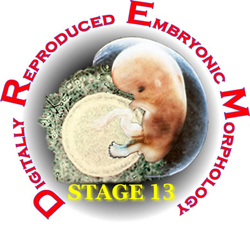

| Opening Screen | Embryo 836 Figures | Download Section Images |
| Browse Sections | Flythrough Animations | 3D Models |
| Help / Instructions | Credits |
Stage 13 embryos have a greatest length of 4 to 6 mm and have an estimated postfertilization age of 32 days. There are 30+ pairs of somites along the body axis, the otic vesicle has formed and four limb buds are present.
This stage is represented by Carnegie embryo # 836 that was given a grade of excellent. It was selected for digital replication because it is one of the top specimens at this stage in the collection. It has a greatest length of 4.0 mm (after fixation) and there are 32 pairs of somites or dermatomyotomes along the body axis. It is considered to be in the early part of the stage.
The embryo was prepared for microscopic examination in 1914. It was fixed in a saturated aqueous solution of mercuric chloride containing 5 per cent glacial acetic acid and hardened in alcohol that was gradually increased from 50 to 70 per cent. It was embedded in paraffin and serially sectioned transverse to the long axis at 15 microns. The 247 sections were mounted on 14 large, glass slides and stained with alum cochineal (i.e., carmine).
The anatomy of this embryo has been well documented in the literature. Multiple photomicrographs taken before and after sectioning are available and details of several reconstructions of this specimen have been published previously.
Instructions for using the disks can be found by going to the Instructions section from the opening screen.